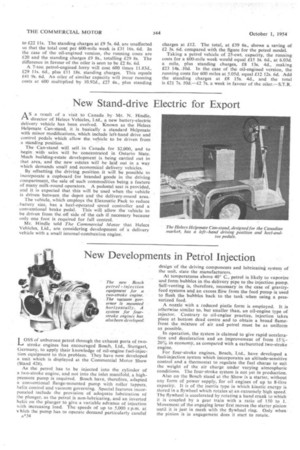New Developments in Petrol Injection
Page 120

If you've noticed an error in this article please click here to report it so we can fix it.
LOSS of unburned petrol through the exhaust ports of twaJ–A stroke engines has encouraged Bosch, Ltd., Stuttgart, Germany, to apply their knowledge of oil-engine fuel-injection equipment to this problem. They have now developed a unit which is displayed at the Commercial Motor Show (Stand 428).
As the petrol has to be injected into the cylinder of a two-stroke engine, and not into the inlet manifold, a highpressure pump is required. Bosch have, therefore, adapted a conventional flange-mounted pump with roller tappets, helix control and vacuum governing. Special features incorporated include the provision of adequate lubrication of the plunger, as the petrol is non-lubricating, and an inverted helix on the plunger to give a variable advance of injection with increasing load. The speeds of up to 5,000 r.p.m. at v hich the pump has to operate demand particularly careful A*34 design of the driving components and lubricating system of the unit, state the manufacturers.
At temperatures above 40° C., petrol is likely to vaporize and form bubbles in the delivery pipe to the injection pump. Self-venting is, therefore, necessary in the case of gravityfeed systems and an excess flow from the feed pump is used to flush the bubbles back to the tank when using a pressurized feed.
A nozzle with a reduced pintIe farm is employed. It is otherwise similar to, but smaller than, an oil-engine type of injector. 'Contrary to oil-engine practice, injection takes place at bottom dead centre and to obtain a broad flamefront the mixture of air and petrol must be as uniform as possible.
In operation, the system is claimed to give rapid acceleration and deceleration and an improvement of from 15%20% in economy, as compared with a carburetted two-stroke engine.
For four-stroke engines, Bosch, Ltd., have developed a fuel-injection system which incorporates an altitude-sensitive control and a thermostat to regulate the fuel charge to suit the weight of the air charge under varying atmospheric conditions. The four-stroke system is not yet in production.
Also on the Bosch stand at the Show is a starter, without any form of power supply, for oil engines of up to 8-litre capacity. It is of the inertia type in which kinetic energy is stored in a flywheel which rotates at an extremely high speed. The flywheel is accelerated by rotating a hand crank to which it is coupled by a gear train with a ratio of 150 to 1. Movement of the engaging lever first moves the starter pinion until it is just in mesh with the flywheel ring. Only when the pinion is in engagement does it start to rotate.




























































































































































